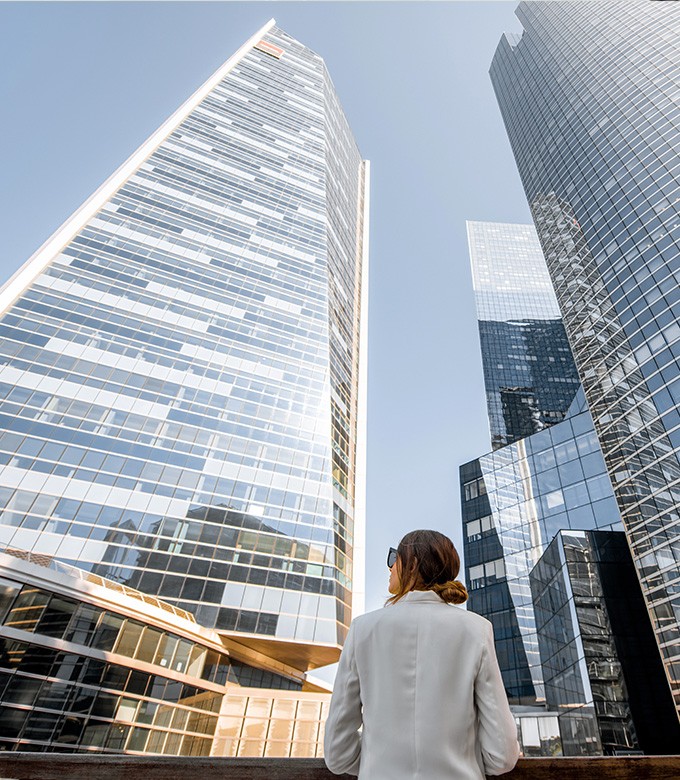Blog
What is a smart building?

How you can easily upgrade your assets?
Today’s smart buildings are delivering real results: reducing costs, improving sustainability and enhancing asset value. It’s more than automation - it’s complete, integrated intelligence across the building lifecycle.
Smart buildings were once defined by motion sensors or app-controlled lighting, but through the latest advanced technologies, modern building systems can optimise and anticipate resource usage, efficiency and comfort, with enormous implications for the built environment and for sustainability.
“A smart building is a space that thinks, learns and evolves to support people, sustainability goals and long-term performance"
What is a smart building? (and why it matters)
A smart building defines the next generation of intelligent buildings. It responds in real time to people, environmental factors and operational demands. Enabled by AI and modern building operating systems (BOS), smart buildings can:
- Detect and respond to real-time occupancy
- Optimise energy use based on behaviour and schedules
- Identify and predict maintenance needs before they escalate
- Continuously learn and improve through data-driven insights
For facilities managers, this translates into streamlined operations, reduced manual intervention and proactive building control. For asset managers and developers, smart buildings can mean long-term efficiency, lower operational costs and stronger asset performance - while supporting sustainability targets and certifications.

Is it possible to transform any building into a smart building?
Absolutely. Most buildings weren’t built for smart integration. Your estate portfolio might be fragmented, ageing and incompatible with modern software and the result is often a patchwork of siloed systems that don’t talk to each other. Each system has its own cockpit, its own data and its own rules. Making even a simple change such as adjusting energy schedules, requires manual updates across multiple platforms. This fragmentation makes it time-consuming to operate, difficult to scale and nearly impossible to optimise cost-effectively.
That’s why consultancy firms and Master System Integrators (MSIs) increasingly recommend deploying a Building Operating System (BOS) such as Trigrr, not just in new developments, but across legacy assets as well. A BOS unifies these disparate systems into one intelligent platform, creating a foundation for long-term adaptability, efficiency and value.
Rather than installing new tech, Trigrr creates a unified, intelligent layer across your existing infrastructure - regardless of age, brand or system complexity - giving your building a brain.
At the heart of Trigrr’s approach is our innovative metalanguage, Trigrrnometry, which enables seamless communication between devices and systems across different generations and manufacturers. As part of our BOS, it brings all the infrastructure into one central platform.
Whether you have old HVAC units, or decades-old CCTV, Trigrr can connect and control them - without replacement. As long as the systems can communicate, whether through open protocols or available APIs, Trigrr can unify them into a single intelligent platform. You’ll see from our client success stories, that our platform has transformed legacy buildings across Europe into high-performing, AI-enabled assets, using what’s already in place.
What are the benefits of a smart building?
At Trigrr, we believe smart buildings should deliver outcomes, not just showcase technology. Our platform is purpose-built to help you:
- Lower energy and maintenance costs through intelligent automation
- Enhance occupant wellbeing through comfort optimisation and intuitive, screen-ready controls that put users back in charge.
- Simplify ESG reporting, backed by robust data.
- Increase asset value through better decision-making, higher certifications (BREAM, WELL, SmartScore) and operational transparency
Firstly, integrators benefit from a streamlined deployment process that connects fragmented systems into a unified platform. Then, facilities teams benefit from easy-to-use dashboards and no-code automation, allowing them to adapt systems in real time without engineering support. Asset managers can access live building insights, performance benchmarking and portfolio-level analytics, all essential for driving value, reducing costs and making informed capital investment decisions.

Do smart buildings require major capital investment?

Not with Trigrr.
Our platform is designed for strategic integration, not system replacement.
With costs starting from just 0.90€ per square meter, Trigrr enables buildings of any age or condition to become smart, scalable and efficient.
There’s no need to strip out existing infrastructure. Instead, we integrate intelligence onto what you already have, unlocking the full potential of your building systems while keeping costs low and ROI high.
Is the system designed for scaling?

Yes, and it’s one of our biggest strengths. Trigrr is built for flexibility across all types of estates: single buildings, multi-site portfolios, and mixed-use developments. Our BOS includes:
- No-code automation, empowering teams without specialist skills
- Open APIs, enabling seamless integration with third-party tools such as workplace management or your favourite BI tool
- Enterprise-grade security, built for compliance from day one
- Flexible deployment options, whether on cloud, full on prem or hybrid, with an architecture designed to align with your IT policy.
How long does it take to set up?
Full deployment can take as little as 10 days, provided that systems are already connected and ready for integration into Trigrr.
Our unique architecture integrates with existing systems quickly, without the need for extensive engineering or lengthy delays. Site scoping, data point mapping, BOS configuration and training are carried out by our trusted integrator partners, those who know the buildings best.This local expertise ensures fast, tailored deployments and is a key enabler of scalable success across portfolios.
Throughout the process, our customer success management team remains closely involved to ensure everything runs smoothly and to support clients in realising the full value of the solution. Once deployed, Trigrr provides immediate visibility and control, transforming operations and data access from day one.
Smart buildings start here
Smart buildings have moved from a luxury to a necessity. They are a practical, immediate opportunity to improve building value, save time and costs and reduce environmental impact.


